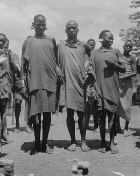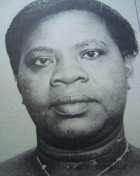Wangari Muta Maathai is known as the first central or eastern African to hold a Ph.D., the first woman head of a university department in Kenya, and the first African woman to win the Nobel Peace Prize in 2004 for ‘her contribution to sustainable development, democracy and peace.’ Maathai was elected as a member of the Kenyan Parliament and served as assistant minister for environment and natural resources between January 2003 and November 2005.
Maathai was born on 1 April 1940 in the village of Ihithe, Nyeri District, in the central highlands of the colony of Kenya. Maathai’s education included boarding school from as early as 11 years of age. Due to her outstanding academic performance, she was able to pursue higher education, a rarity for girls in rural areas of Kenya. In 1960, Maathai was one of about 300 students who participated in a programme that saw Kenyans benefitting from education in Western nations. She received a scholarship to study at Mount St. Scholastica College (now Benedictine College), in Atchison, Kansas. There, she earned a bachelor’s degree in biology with minors in chemistry and German, and went on to earn a master’s degree in biological sciences at the University of Pittsburgh. It was during her time in Pittsburgh that she was first exposed to efforts at environmental restoration when local environmentalists pushed to rid the city of air pollution.[1]
Returning to Kenya, Maathai was appointed research assistant to a professor of zoology at the University College of Nairobi. But when she arrived at the university to start her new job, she was informed that it had been given to someone else. Maathai believed this was because of gender and ethnic bias against her as a woman and as a member of the Kikuyu ethnic group.[2]
In April 1966, she met Mwangi Mathai, another Kenyan who had studied in America, who would become her husband in 1969. She also rented a small shop in the city and established a general store, at which her sisters worked. Eventually, despite the scepticism and even opposition of the male students and faculty, she was able to earn a Ph.D. at the University College of Nairobi. She worked her way up through the academic ranks, eventually becoming head of the veterinary medicine faculty.[3]
Activism
While working at the University College of Nairobi, Maathai started campaigning for equal benefits for the women staff, attempting to turn the academic staff association into a union. The courts denied this bid, but many of her demands for equal benefits were later met.[4] In the early 1970s, she also became involved in a number of civic organizations. She was a member of the Nairobi branch of the Kenya Red Cross Society, becoming its director in 1973, and she was a member of the Kenya Association of University Women.
Following the establishment of the Environment Liaison Centre in 1974, Maathai was asked to be a member of the local board, eventually becoming the chair. The Environment Liaison Centre worked to promote the participation of non-governmental organizations in the work of the United Nations Environment Programme (UNEP), whose headquarters was established in Nairobi in 1972. Maathai also joined the National Council of Women of Kenya (NCWK). Through her work at these various volunteer associations, it became evident to Maathai that a root of most of Kenya’s problems was environmental degradation.[5]
In 1974, Maathai’s husband campaigned for a seat in Parliament and won. During the course of his campaign, he had promised to find jobs to limit the rising unemployment in Kenya. This led his wife to become involved in organizing work for poor people, and eventually this became a national grassroots organization, providing work and improving the environment at the same time. The project has made significant headway against Kenya’s deforestation.
In 1977, Maathai proposed tree planting to the local council, and on 5 June 1977, marking World Environment Day, the NCWK marched in a procession from Kenyatta International Conference Centre in downtown Nairobi to Kamukunji Park on the outskirts of the city, where they planted seven trees in honour of historical community leaders. This was the first ‘green belt’; it marked the beginning of a campaign first known as the ‘Save the Land Harambee’ and later the Green Belt Movement. Maathai encouraged the women of Kenya to plant tree nurseries throughout the country, searching nearby forests for seeds to grow trees native to each area. She agreed to pay the women a small stipend for each seedling that was later transplanted.
Her activism spilled over into her personal life when she and her husband instituted divorce proceedings in 1977. Her husband claimed during the proceedings that she was ‘too strong-minded for a woman’ and that he was ‘unable to control her.’ In addition to naming her as ‘cruel’ in court filings, he publicly accused her of adultery with another member of Parliament.[6] After the judge ruled in favour of her husband, Maathai commented in an interview that the judge was incompetent, which led to her arrest and sentencing for six months. Following an application by her lawyer, she was released after three days. Shortly after the divorce, her former husband sent a letter via his lawyer demanding that she drop his surname, but she instead chose to add an extra a.
Maathai focused her attention after her divorce on the NCWK, which was an umbrella organization consisting of many different women’s organizations in the country. Her efforts to run for the leadership position within this structure were hampered by interference from President Daniel arap Moi, who was attempting to limit the influence of Kikuyus, including in volunteer civic organizations. In 1980, Maathai eventually succeeded in becoming chairwoman of NCWK and managed to ensure its financial survival by increasing its focus on the environment and growing its presence. She tried to take up a parliamentary seat in her home region but was frustrated due to her pro-democracy stance and evicted from her home.[7]
At this point, Maathai began to pour all her efforts into the Green Belt Movement, which had established a partnership with the Norwegian Forestry Society and received seed money from the United Nations Voluntary Fund for Women. These funds allowed the movement to expand, hire additional employees to oversee operations and continue to pay a small stipend to the women planting seedlings throughout the country. In the latter half of the 1980s, the Kenyan government came down against Maathai and the Green Belt Movement, invoking a colonial-era law prohibiting groups of more than nine people from meeting without permission. In 1988, the Green Belt Movement carried out pro-democracy activities, such as registering voters for the election and pressing for constitutional reform and freedom of expression. The government, however, was not interested in reform and practised electoral fraud in the elections to maintain power.
In October 1989, when she learned about a plan to construct a 60-storey building in Uhuru Park, Maathai was propelled into action. She wrote many letters in protest, to newspapers, the president and other officials, as well as international organizations. Her actions resulted in backlash and character assassination, with the government claiming that Maathai was a crazy woman and also attacking the Green Belt Movement’s legitimacy and credibility. The building project started, despite Maathai seeking an injunction in the Kenya High Court to halt construction, but foreign investors eventually pulled out due to all the adverse publicity.
In his first public comments pertaining to the project, President arap Moi said those who opposed it had ‘insects in their heads.’ He later suggested that Maathai be a proper woman according to ‘African tradition’ and respect men and be quiet. She was forced by the government to vacate her office, so the Green Belt Movement moved into her home. The government then audited the organization in an apparent attempt to shut it down.
In 1992, it came to the attention of Maathai and other pro-democracy activists that a list of people was targeted for assassination and a government-sponsored coup was possible. With a group of other activists, she presented this information to the media, calling for a general election. Maathai was later arrested but released on bail following pressure on the government by foreign politicians. Maathai participated in several organized activities at this time, including a hunger strike, to put pressure on the government to release political prisoners, often being subjected to physical violence, until early 1993, when the prisoners were finally released. Increasingly Maathai was being recognized with various international awards, but the government of Kenya still did not appreciate her work.
In 1998, Maathai gained worldwide attention when the Kenyan president backed development of a luxury housing project and building began by clearing hundreds of acres of Karura Public Forest.[8] She went with the Green Belt Movement to the forest to plant trees and protest its destruction. The following year, a group of protesters, including Maathai, returned to the forest and many were attacked by suspected government thugs. However the police refused to investigate the incident.
After so many years of activism and abuse by the arap Moi government, in December 2002, Maathai was elected to Parliament as Mwai Kibaki defeated the incumbent in the presidential election. Kibaki named Maathai as deputy minister in the Ministry of Environment, Natural Resources and Wildlife in January 2003. Maathai died in Nairobi in 2011 of cancer.
Movement-building legacy
Today, the Green Belt movement in Kenya has planted more than 50 million trees to prevent soil erosion and provide firewood for cooking fires. A 1989 United Nations report noted that only nine trees were being replanted in Africa for every 100 cut down, causing serious problems of deforestation: soil runoff, water pollution, difficulty finding firewood, lack of animal nutrition and so on. The tree-planting programme was carried out primarily by women in villages who, through protecting their environment and receiving payment for planting the trees, are able to better care for their families.
Maathai’s extraordinary legacy is about more than the awards bestowed on her: it is one of steadfast beliefs and commitment to justice, democracy and environmental sustainability. Her genius was in recognizing the inter-relatedness of local and global problems, and seeing that these problems can only be addressed as citizens themselves find their voices and courage to act. Maathai saw in the Green Belt Movement’s tree planting both a good in itself and an entry point, a way in which women could discover that they were not powerless in the face of autocratic husbands, village chiefs and a ruthless government.[9]
Through creating their own tree nurseries—at least six thousand throughout Kenya—and planting trees, women began to control their own firewood, an enormous power shift that also freed up time for other pursuits. Then, through popular education, village women who had watched public forests be used by the arap Moi regime to grant political favours, were galvanized to see the forests differently: as something they as citizens had claim to. Through the Green Belt Movement, village women also came to see that a narrow focus on export commodities such as coffee, at the expense of environmentally-appropriate food crops, was an inheritance of colonialism reinforced by the International Monetary Fund’s policies.
Maathai’s foresight in understanding that sustainable development, democracy and peace are indivisible concepts cannot be denied. She saw that protecting the environment is not a luxury, but a necessity, because people cannot survive without clean drinking water, which comes from the forested mountains, nor can they live without the food that is grown on fertile fields watered by the rains.[10] The wisdom of empowering and mobilizing local communities is practically demonstrated by Maathai’s Green Belt Movement, especially in this era of ‘ngo-ization’ in which many organisations have lost their connection to the voice and power of grassroots communities.
—
Footnote:





